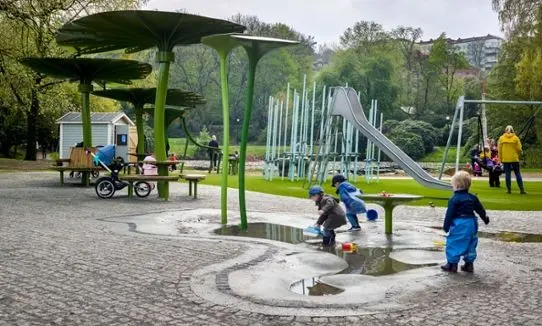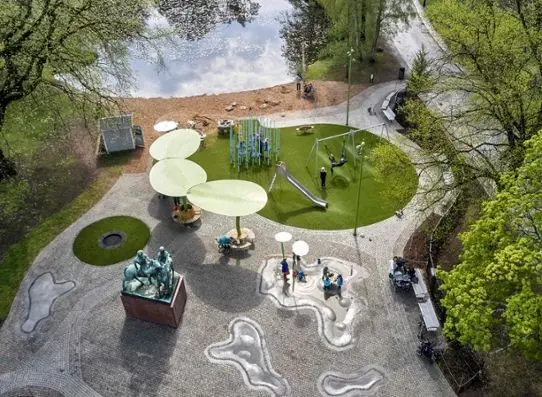Rain playground in Gothenburg – a playful solution to a wet challenge
Gothenburg is renowned for its unpredictable weather. On average, it rains in the city every third day and climate change is leading to even more rain and extreme rainfall, hence the need for new ways to deal with rainwater. The City of Gothenburg has decided to invest in becoming the world’s best city when it rains, an investment that includes the Rain Playground.
The example in brief
- The City of Gothenburg has taken an innovative approach to dealing with rain by building the Rain Playground. Started in 2017, the project was intended to combine play with water management, and to involve citizens in its design. The result was a playground that is not only fun and safe but also a role model for more inclusive climate adaptation.
- The playground is equipped with large, leaf-shaped canopies and gutters that collect and direct the rainwater in an educational manner. The leaf canopies can deal with large quantities of water at the same time as providing aesthetic and playful experiences.
- Making the playground accessible to as many people as possible was a key concern of the project. Wheelchair-adapted paths and playground equipment ensure that more children and adults can participate, making the playground an inclusive and inspiring meeting place.
The aim of Gothenburg’s Rain Playground was to create a meeting place that was fun to use even in rainy weather, and that engaged citizens and considered their ideas when identifying solutions. The playground is not simply somewhere for children to have fun but also a symbol of how future rainy days can be managed in a playful and inclusive manner. The watchwords for the Rain Playground project were inclusion and collaboration.

The playground is somewhere for children to have fun and a symbol of how future rainy days can be managed in a playful and inclusive manner. Photo Ulf Celander
An equity perspective has been central to the design of the playground. As a meeting place, the playground contributes to countering social inequality and creating a more inclusive society. When measures are implemented fairly, it is ensured that residents have the opportunity to participate and benefit from the investment regardless of their backgrounds and situations. When measures lack an equity perspective, there is a risk that they will exacerbate inequities in society.
“The Rain Playground is a wonderful collaboration between the city’s residents and the participating artists and architects. Through dialogue, we have created a place where everyone can meet and play – regardless of the weather,” says project manager Emma Sjögren of the city’s Urban Environment Department.
Managing rainwater for a safe and fun playground
Climate change is leading to more and heavier precipitation, increasing the importance of dealing with rainwater in urban areas. This presents a significant challenge to city’s infrastructure, the urban environment and the health of residents. It is also important that children have safe and enjoyable environments in which to play, and that encourage them to be outdoors in all weathers. When the time came to refurbish the old playground at Näckrosdammen, it was decided to take the opportunity to both develop water management and create an inclusive playground that could deal with increasing rainfall in a creative manner.

An inclusive playground has been created that can deal with increasing rainfall in a creative manner. Photo Ulf Celander
The redevelopment of the playground was not simply a matter of leading rainwater away; rather, considerable emphasis was placed on ensuring that the chosen solutions were inclusive and child-friendly. The Rain Playground fulfils an important function by creating a safe and accessible environment for children to play in, as well as meeting many of the social and practical needs of urban development.
The collaboration provided both aesthetic and technical solutions
The Rain Playground at Näckrosdammen is the result of an extensive co-creation project in which the residents of Gothenburg have actively participated. Collaboration between residents, architects and artists was key to the success of the project and the City employed a number of different methods to engage citizens in the design. Children and adults were given the opportunity to share their ideas during the Gothenburg Culture Festival, when a suggestion box was installed at the playground and views were elicited via social media. The suggestions received included how rainwater could be used in a playful and educational way, for example, to create puddles and interactive artworks.
The next stage was for landscape architects and artists to consider both the technical requirements of water management and the aesthetic and playful aspects that residents wanted to see. The result was a playground in which rainwater is viewed as an asset. Water is collected in the large leaf-shaped canopies and gutters, creating an experience that is both playful and educational, and that encourages children to play outdoors. It was also important to include children and parents with disabilities by creating a design with wheelchair-accessible paths and play areas.
The collaboration culminated in a playground that provides a safe, inspirational and communal environment in which rainwater is viewed as an asset in play, and that meets the technical requirements of water management. The Rain Playground is both an educational resource and an important meeting place for children and families.
Broad dialogue provided an understanding of the equity perspective
The co-creation process and a broad dialogue led to creative and functional solutions that reflect the needs of residents. The process demonstrated that targeted interventions, such as collaborations with playground associations and outreach activities, can ensure that even groups that do not normally participate in urban planning processes have a chance to exert influence. This helped to achieve a wider understanding of how accessibility and social justice can be integrated into the design. One of the major challenges was to balance residents’ ideas with technical and safety requirements. Many of the suggestions submitted involved the use of the water in a nearby pond but, due to health and safety concerns, these could not be implemented. Clearly conveying these limitations while maintaining engagement was crucial to the project’s success.
Involving various professions – such as landscape architects, artists and safety experts – from the beginning of the project was also vital to achieving an end-result that combines both the aesthetic and functional aspects.

An inclusive playground has been created that can deal with increasing rainfall in a creative manner. Photo Ulf Celander
Funding
The Rain Playground was financed as part of Gothenburg's 400th anniversary celebrations with support from both the municipality and private stakeholders. The budget for the project was SEK 8.3 million.
Evaluation
The playground has become a much-appreciated meeting place and an example of how citizen engagement and sustainable urban development can go hand in hand. It represents not only a technical solution to climate challenges but also a symbol of democratic participation and just resilience. The Rain Playground was nominated for the City of Gothenburg’s 2019 Architectural Prize for Best Building. This nomination is proof of the national recognition that the playground’s combination of technical solutions and aesthetic value has garnered, and that it has become a model project for sustainable urban development and architecture.
